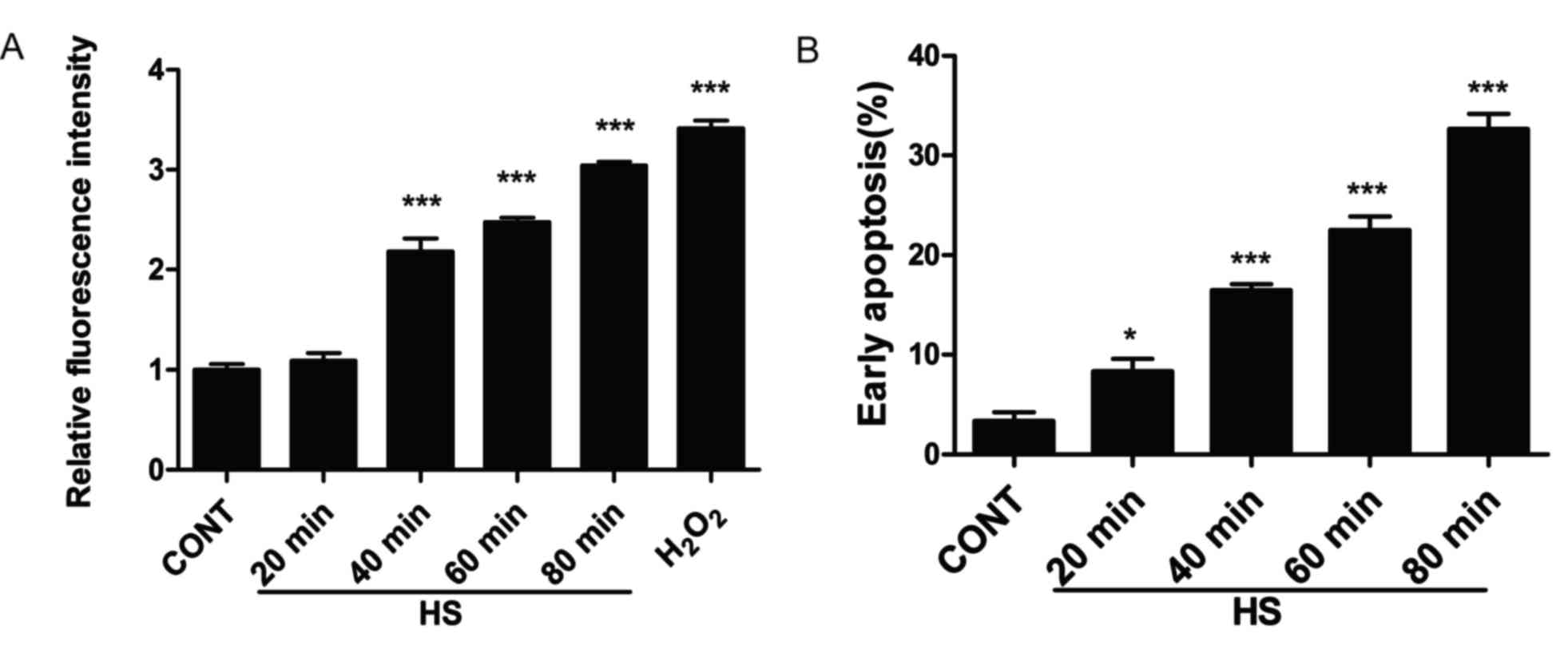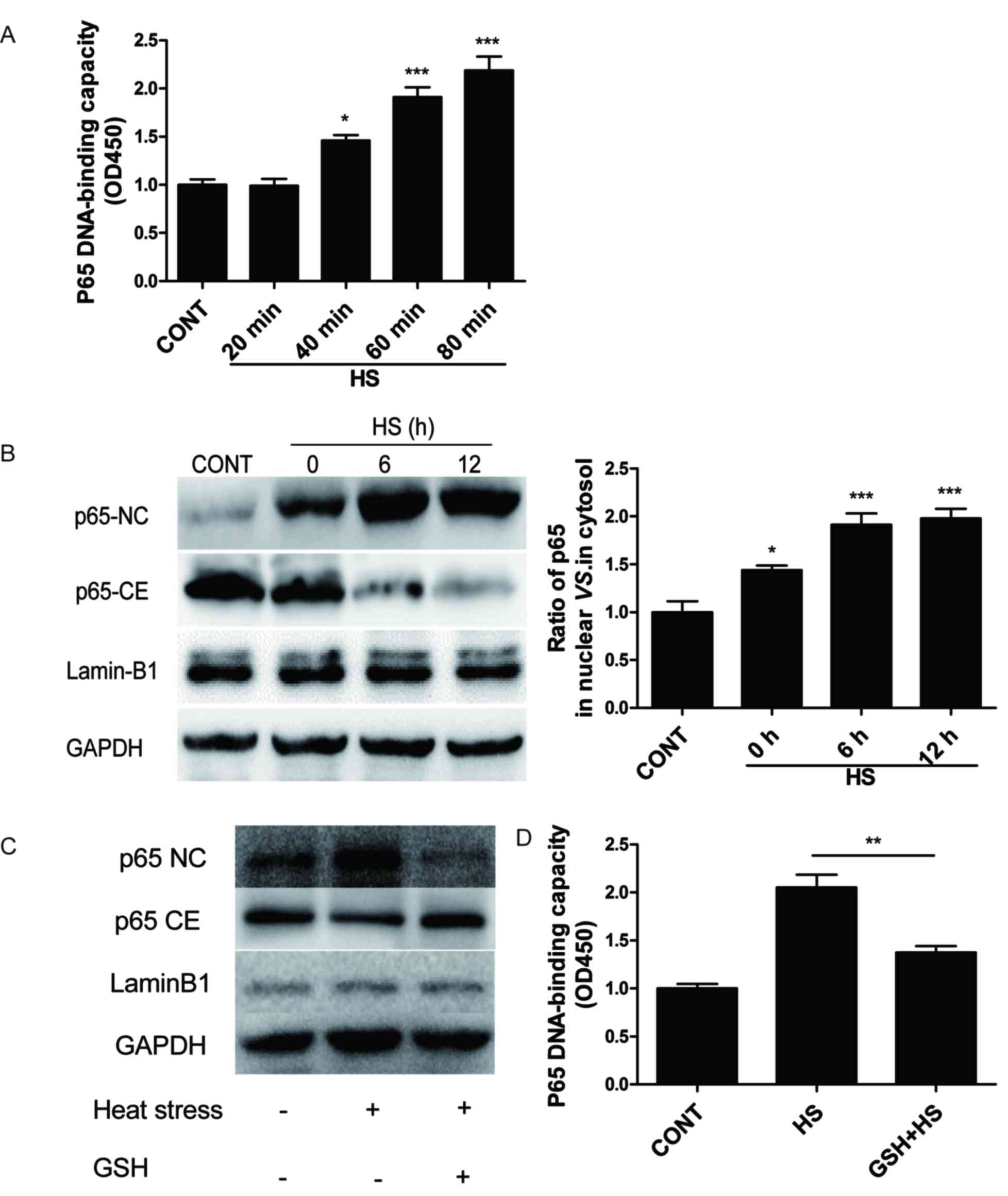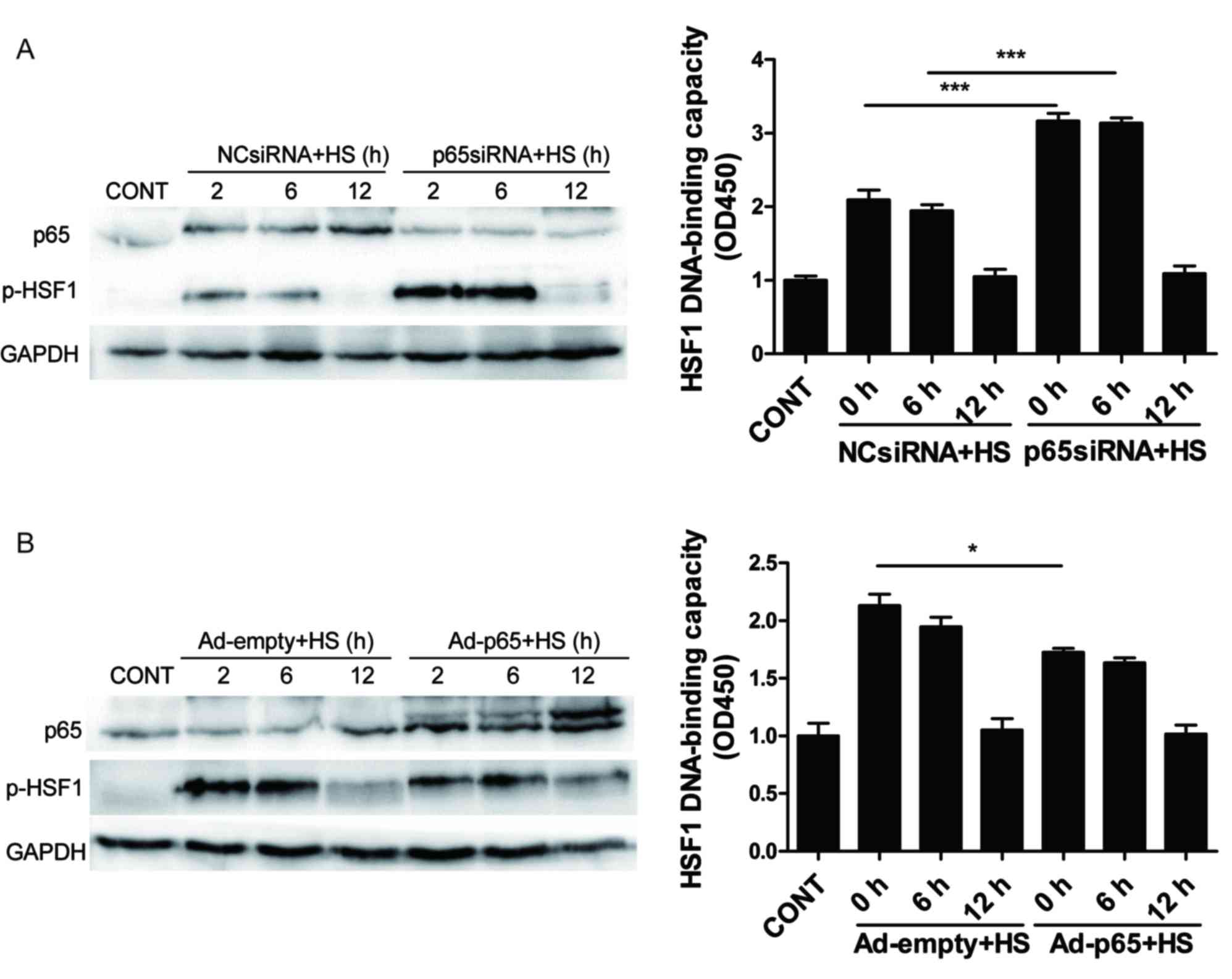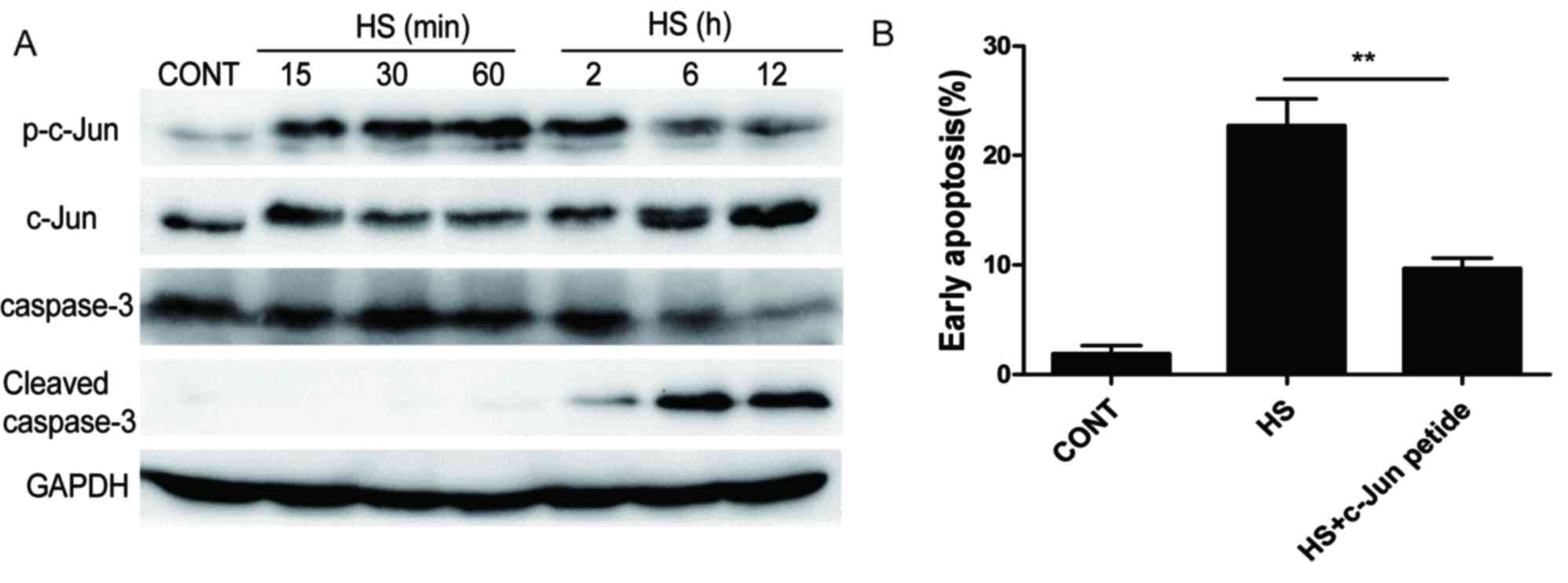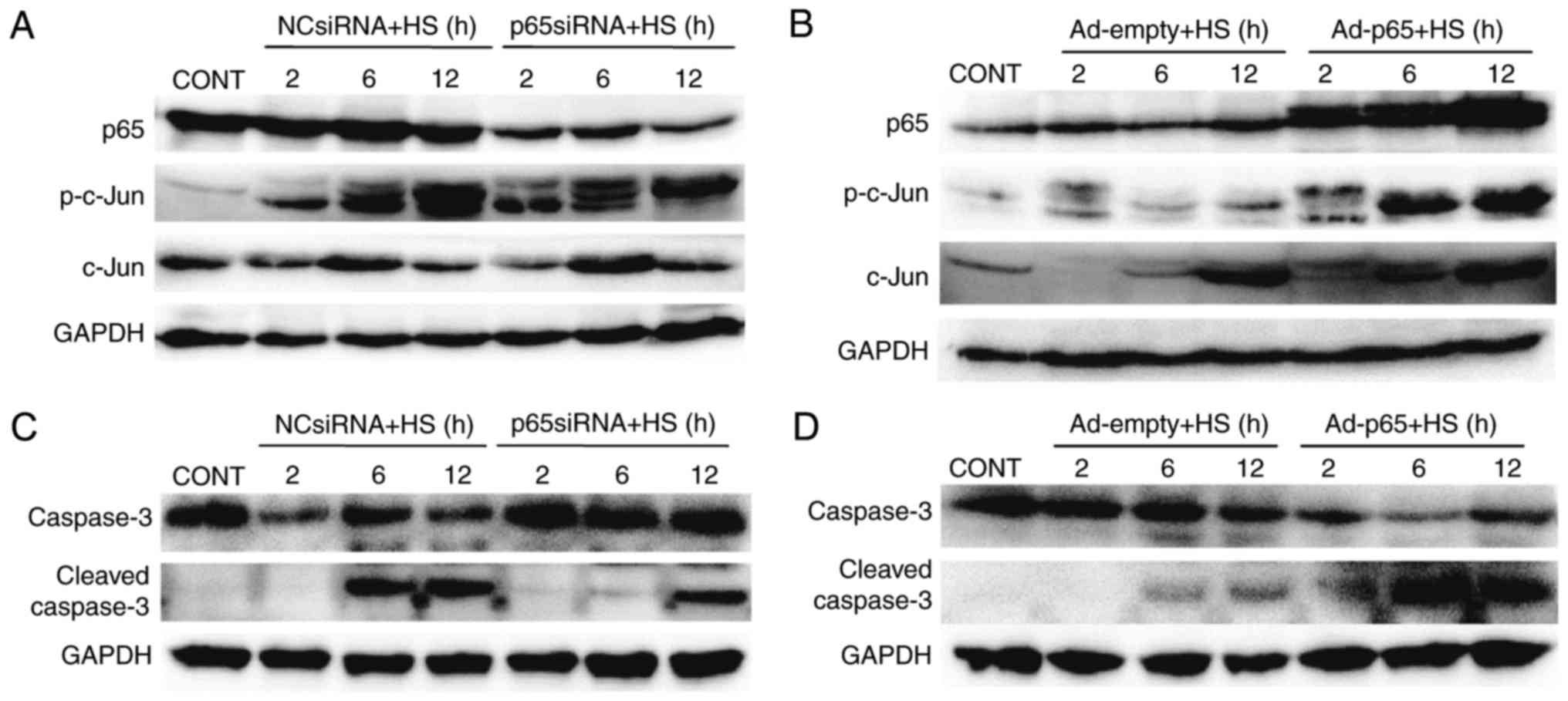NF‑κB regulates HSF1 and c‑Jun activation in heat stress‑induced intestinal epithelial cell apoptosis
- Authors:
- Published online on: December 6, 2017 https://doi.org/10.3892/mmr.2017.8199
- Pages: 3388-3396
Abstract
Introduction
Intestinal epithelial cells are crucial components of the intestinal mucosal barrier, and damage to these cells increases the permeability of this barrier, which may lead to increased translocation of gut-derived bacterial endotoxins (1). Previous studies on the effects of heat stress on these cells have reported a significant level of apoptosis in the rat small intestine (2,3). Indeed, apoptosis in the small intestine was demonstrated to serve a major role in the pathogenesis of heat stroke (2,3).
Heat stress may induce the production of reactive oxygen species (ROS), which may lead to cellular dysfunction and cell death (3–5). Nuclear factor (NF)-κB was previously reported to be induced by a multitude of stimuli, such as cytokines, oxidative stress or thermal stress (6). A previous study demonstrated that NF-κB is activated in response to heat stress in HeLa human cervical cancer cells (6). Many inducers of NF-κB expression may be inhibited by antioxidants, which suggested that ROS may modulate the signal transduction pathway leading to NF-κB activation (7,8). However, the role of ROS heat stress-induced NF-κB activation in IEC-6 rat small intestinal epithelial cells remains unclear. Cultured IEC-6 cells are similar to the mature intestinal epithelium (3), and were used as a model to investigate the mechanisms of intestinal epithelial cell survival and apoptosis.
The heterodimeric NF-κB complex comprises two DNA binding subunits, p50 and p65, which may form either homo- or heterodimers (9). NF-κB signaling is a transcriptional regulator of several genes that are involved the inflammatory response, cell growth, cell survival and apoptosis (9,10). A number of studies have reported that NF-κB activation may downregulate proapoptotic signaling and thus prevent apoptosis in many cells types (10,11). By contrast, other studies have demonstrated that NF-κB activation may by an inducer of apoptosis (12,13). However, the mechanisms underlying heat stress-induced apoptosis in IEC-6 cells and the involvement of NF-κB activation are still unknown.
Heat shock transcription factor 1 (HSF1) is a master regulator of the genes that encode molecular chaperones and serves a role in the attenuation of apoptosis induced by multiple factors (14,15). Upon heat shock, HSF1 rapidly translocates into the nucleus and exhibits the properties of a stable trimer which correlates with the acquisition of DNA binding activity; furthermore, the transcriptionally active form of HSF1 becomes inducibly phosphorylated (16). Previous studies have reported interactions between HSF1 and NF-κB, which serve opposite roles in cytoprotection and cell injury (17).
The signal-transducing transcription factor c-Jun, also known as activating protein 1 (AP1), has previously been reported to serve a role in cell cycle progression, differentiation and transformation, as well as apoptosis (18,19). c-Jun protein activity is regulated by phosphorylation at specific sites; for example, Ser63 phosphorylation in the transactivation domain leads to an increased ability of c-Jun to activate the transcription of target genes (20). Previous studies have demonstrated that c-Jun is able to physically interact with NF-κB p65 through the Rel homology domain (21). Nevertheless, whether NF-κB can interact with HSF1 and c-Jun, and thereby influence IEC-6 cell apoptosis, still remains unknown.
Results from the present study demonstrated that heat stress-induced increases of ROS levels may lead to NF-κB activation, which in turn may activate caspase-3 and, thus, apoptosis in IEC-6 cells. In addition, a putative role for NF-κB in the regulation of HSF1 and c-Jun activation induced by heat stress treatment was investigated. This study also aimed to examine whether HSF1 might prevent apoptosis and c-Jun activation-induced apoptosis in the same experimental settings.
Materials and methods
Cell culture and treatments
Approximately 2×106 IEC-6 cells (ATCC, Manassas, VA, USA) were grown as a monolayer in Dulbecco's Modified Eagle's Medium (DMEM) supplemented with 10% heat inactivated fetal bovine serum (FBS) (Invitrogen; Thermo Fisher Scientific, Inc., Waltham, MA, USA), 100 U/ml of penicillin, and 100 µg/ml of streptomycin (Invitrogen; Thermo Fisher Scientific, Inc.) at 37°C in a humidified atmosphere of 5% CO2 and 95% air. To induce heat stress, culture dishes were placed into a circulating water bath at 43±0.5°C for indicated times; control cells were held at 37±0.5°C. Following heat-stress culture, the media was replaced and cells were further incubated at 37°C for 0, 2, 6 and 12 h.
Measurement of ROS levels
Levels of intracellular ROS were assessed using a ROS assay kit (Beyotime Institute of Biotechnology, Haimen, China). Dichlorofluorescein diacetate (DCFH-DA; Molecular Probes; Thermo Fisher Scientific, Inc.) enters the cells and reacts with ROS, producing the fluorophore DCF. Briefly, cells were either kept untreated or incubated at 43°C for 20 (short-term heat stress), 40, 60 (moderate-term heat stress) and 80 min (long-term heat stress), followed by an additional incubation at 37°C for 6 h. IEC-6 cells (3×105) with the antioxidant glutathione (GSH; 100 µmol/l) for 1 h, followed by exposure to heat stress at 43°C for 60 min. Control cells were always incubated at 37°C. Cells (3×105) were harvested, washed with serum-free DMEM culture medium, and stained with 10 µM DCFH-DA for 30 min at 37°C in the dark. Following this, the cells were harvested by trypsin, the supernatants was removed by centrifugation (1,000 × g for 3 min at room temperature) and resuspended in serum-free DMEM culture medium three times. The fluorescence intensity was determined using a flow cytometer (FACSCanto™ II; BD Biosciences, San Jose, CA, USA) and analyzed using FlowJo software version 9.0 (FlowJo LLC, Ashland, OR, USA).
Flow cytometric analysis of cell apoptosis
Cell apoptosis was analyzed by flow cytometry with annexin V-fluorescein isothiocyanate (FITC) Apoptosis Detection kit (Invitrogen; Thermo Fisher Scientific, Inc.), according to the manufacturer's protocol. Briefly, cells were either kept untreated or incubated at 43°C for 20, 40, 60, 80 min, followed by an additional incubation at 37°C for 6 h. Control cells were always incubated at 37°C. IEC-6 cells (1×106) were collected, washed in ice cold PBS and resuspended in the binding buffer containing 5 µl annexin V-FITC (5 µg/ml). Following incubation at room temperature for 10 min, the buffer was removed by centrifugation (1,000 × g, 3 min, room temperature) and cells were resuspended in reaction buffer containing 10 µl propidium iodide (PI; 5 µg/ml) for 10 min at room temperature. Flow cytometric analysis was immediately performed to detect apoptosis (FACSCanto™ II; BD Biosciences), The combination of Annexin V-FITC and propidium iodide allows for the distinction between early apoptotic cells (Annexin V-FITC positive), late apoptotic and/or necrotic cells (Annexin V-FITC and propidium iodide positive), and viable cells (unstained). The fluorescence intensity was analyzed using FlowJo software version 9.0 (FlowJo LLC, Ashland, OR, USA).
Small interfering (si)RNA transfection
siRNAs for NF-κB p65 and HSF1 were designed and synthesized by Shanghai GenePharma Co. Ltd. (Shanghai, China). The sequence of each siRNA and the negative control (non-targeting siRNA) are shown in Table I. Prior to transfection, 1×105 IEC-6 cells were plated onto a 6-well plate (Nest Biotechnology Co., Ltd., Wuxi, China) and incubated for 24 h to 30–50% confluence at 37°C. Cells were transfected with 1 µM siRNA (all siRNAs were used at this concentration) using siRNAMate Transfection Reagent (Shanghai GenePharma Co. Ltd.) and incubated for 12 h at 37°C, according to the manufacturer's protocol. Cells were incubated following 48–72 h at 37°C for further experiments.
Adenoviral infection
Adenoviruses (Ad) that constitutively overexpressed p65 (Ad-p65) or empty construct (Ad-empty) were constructed by Vigene Biosciences (Jinan, China). Cells were infected with the adenoviruses in serum-free DMEM for 6 h and then the media was replaced with DMEM supplemented with 10% FBS. Cells (1×105/well) were infected with 100 MOI Ad in serum-free DMEM for 6 h at 37°C, according to the manufacturer's protocol, following which the media was replaced with DMEM supplemented with 10% FBS, cells were incubated following 48–72 h at 37°C for further experiments.
Western blot analysis
IEC-6 cells (~1×106) were kept at 37°C or 43°C for 60 min, and further incubated for 2, 6 or 12 h at 37°C. For cytoplasmic and nuclear protein of p65 extraction, cells were lysed in NE-PER Nuclear and Cytoplasmic Extraction Reagents (Pierce; Thermo Fisher Scientific, Inc.) according to the manufacturer's protocol. The IEC-6 cells were homogenized in radioimmunoprecipitation buffer with phenylmethylsulfonyl fluoride (Sigma-Aldrich; Merck KGaA). Following centrifugation at 14,000 × g at 4°C for 10 min, the supernatants were used for western blot analysis. Protein concentration was determined using a Bicinchoninic Acid Protein assay kit (Thermo Fisher Scientific, Inc.). Proteins (20 µg/well) were separated by SDS-PAGE using 10% SDS polyacrylamide gels and transferred onto polyvinylidene difluoride membranes. Membranes were blocked with blocking solution (5% skimmed milk diluted with PBS) at room temperature for 2 h, followed by incubation with primary antibodies overnight at 4°C. The following rabbit primary antibodies were used at a 1:2,000 dilution: p65 (cat. no. Ab16502; Abcam, Cambridge, MA, USA), HSF1 (cat. no. Ab59963; Abcam), phosphorylated (p)-HSF1 (cat. no. Ab52757; Abcam), Lamin-B1 (cat. no. Ab16048; Abcam), c-Jun (rabbit antibodies; cat. no. 9165p; Cell Signaling Technology, Inc., Danvers, MA, USA), phosphorylated (p)-c-Jun (rabbit antibodies; cat. no. 8222S; Cell Signaling Technology, Inc.), caspase-3 (rabbit antibodies; cat. no. 14220S; Cell Signaling Technology, Inc.), cleaved caspase-3 (rabbit antibodies; cat. no. 9654S; Cell Signaling Technology, Inc.) and GAPDH (rabbit antibodies; cat. no. ab70699; Abcam). An anti-rabbit horseradish peroxidase-conjugated immunoglobulin G antibody (cat. no. TA130023; 1:5,000; OriGene Technologies, Inc., Beijing, China) was used as the secondary antibody for incubation for 2 h at room temperature. Antibodies were detected with Enhanced Chemiluminescence Western Blot Detection reagent (Pierce; Thermo Fisher Scientific, Inc.). Membranes were exposed to light-sensitive film and quantified using ImageJ software (version 1.3.4.67; National Institutes of Health, Bethesda, MD, USA).
Measurement of p65 and HSF1 DNA-binding capacity by ELISA
Nuclear extracts were prepared from treated and control cells (~5×106 cells) using a Nuclear Extract kit (Active Motif, Shanghai, China) according to the manufacturer's protocol. The ability of p65 and HSF1 to bind the DNA consensus sequence was assessed using an ELISA-based TransAM NF-κB kit (cat. no. 40096; Active Motif, Carlsbad, CA, USA) and an ELISA-based TransAM HSF1 kit (cat. no. 47096; Active Motif), according to the manufacturer's protocol, quantitative analysis was performed by spectrophotometry at 450 nm using an automatic microplate reader (SpectraMax® M5; Molecular Devices, LLC, Sunnyvale, CA, USA).
Statistical analysis
All data were analyzed for statistical significance using SPSS 13.0 software (SPSS, Chicago, IL, USA). Data were expressed as the mean ± standard deviation from at least three independent experiments performed in duplicate. One-way analysis of variance was performed followed by Fisher's least significant difference post hoc test for multiple comparisons. P<0.05 was considered to indicate a statistically significant difference.
Results
Heat stress increases ROS generation and apoptosis in IEC-6 cells
As ROS generation serves an important role in heat stress (3–5), the effects of heat stress on ROS accumulation was examined in IEC-6 cells. IEC-6 cells were exposed to heat stress (43°C) for different time intervals (20, 40, 60 and 80 min), followed by an additional incubation at 37°C for 6 h in fresh media. Intracellular ROS levels increased in a time-dependent manner (Fig. 1A). In addition, apoptotic rates were quantitative using flow cytometry. Cells were exposed to different durations of heat stress, and the results demonstrate that the number of early apoptotic cells gradually increased and reached a peak of 32.37% in IEC-6 cells exposed incubated at 43°C for 80 min (Fig. 1B).
Role of ROS in activating p65 in heat stress-treated IEC-6 cells
Compared with the untreated control cells, the capacity of p65 to bind to DNA in IEC-6 cells was not modified at 20 min of heat stress at 43°C (Fig. 2A). By contrast, at 40 min heat stress, the DNA-binding capacity of p65 increased and continued to increase significantly at 60 and 80 min (Fig. 2A). Additionally, a time course of p65 activation was analyzed in heat stressed IEC-6 cells at 43°C for 60 min followed by a recovery period at 37°C for 0, 6, or 12 h. When nuclear and cytoplasmic extracts of these timepoints were collected and analyzed by western blot, nuclear levels of p65 increased as the recovery time increased (Fig. 2B). Collectively, these data indicated that heat stress may induce the activation of NF-κB p65, but this event seems not to occur during 20 min of heat stress at 43°C (short-term heat stress).
The role of heat stress-induced ROS generation in p65 activation was examined by pretreating IEC-6 cells with the antioxidant glutathione (GSH; 100 µmol/l) for 1 h, followed by exposure to heat stress at 43°C for 60 min. Cells pretreated with GSH significantly decreased the heat stress-mediated translocation of p65 to nucleus and the binding capacity of p65 to DNA (Fig. 2C and D, respectively). These data suggested that heat stress treatment of IEC-6 cells activated the NF-κB p65 pathway through the release of ROS.
p65 and HSF1 activation is involved in heat stress-induced apoptosis in IEC-6 cells
To clarify the role of NF-κB p65 and HSF1 in heat stress-induced apoptosis in IEC-6 cells, the effects of p65-siRNA and HSF1-siRNA knockdown, as well as Ad-p65 overexpression were examined (Fig. 3A-C). Following p65-siRNA mediated knockdown, apoptosis was significantly reduced in heat stress-treated IEC-6 cells (Fig. 3D). By contrast, apoptosis was markedly increased in heat stress-treated cells that were co-treated with Ad-p65 compared with the same cells transfected with Ad-empty control (Fig. 3E). These observations implied that activated p65 may be able to mediate heat stress-induced apoptosis in IEC-6 cells. In addition, heat stress-induced IEC-6 cells co-treated with HSF1-siRNA exhibited a significant increase in apoptosis, which demonstrated that HSF1 may serve an antiapoptotic role in IEC-6 cells (Fig. 3C and D).
Role of p65 in HSF1 activation in heat stress-induced apoptosis in IEC-6 cells
Whether HSF1 activation was linked with NF-κB signaling in the experimental settings was investigated. p65-siRNA-mediated knockdown significantly increased the heat stress-induced phosphorylation of HSF1 as well as the HSF1 DNA-binding capacity at 2 and 6 h post-heat stress exposure compared with the heat stress-treated cells that were co-treated with the NC-siRNA control, no significant change was observed at 12 h post-heat stress. HSF1 phosphorylation occurred early (0 and 6 h) following heat stress, and HSF1 phosphorylation level returned to normal at 12 h following heat stress, which demonstrated that HSF1 is not constitutively phosphorylated after heat stress. (Fig. 4A and B, respectively). Ad-p65 overexpression led to a slight decrease in HSF1 phosphorylation in heat stress-treated cells, compared with Ad-empty treated IEC-6 cells at 2 h post-heat stress, no significant change was observed at 6 and 12 h post-heat stress (Fig. 4C). Similar results were observed for HSF1 DNA-binding activity (Fig. 4D). These results indicated that p65 activation may have potential inhibitory effects on heat stress-induced HSF1 activation.
Phosphorylation of c-Jun is necessary for apoptosis in heat-stressed IEC-6 cells
To examine the effects of heat stress on c-Jun activation and expression, IEC-6 cells were exposed to 43°C heat stress for the indicated times. Heat stress resulted in an increase in the phosphorylation level of c-Jun within 15 min of exposure, reached a peak at 2 h and subsequently began to decline (Fig. 5A); the rapid increase of c-Jun phosphorylation on Ser63 and subsequent accumulation of c-Jun protein appeared to occur in a time-dependent manner. In addition, heat stress treatment resulted in the increased cleavage of caspase-3 at 2 h of exposure and was expressed at high levels for 12 h, which indicated the activation of apoptosis.
To determine whether c-Jun phosphorylation is necessary for apoptosis, IEC-6 cells were exposed to heat stress in the presence or absence of c-Jun peptide, which effectively acts as c-Jun inhibitor. The inhibition of c-Jun phosphorylation resulted in a significant decrease in the number of apoptotic IEC-6 cells (Fig. 5B). These results suggested that c-Jun phosphorylation may be involved in heat stress induced apoptosis in IEC-6 cells.
Influence of NF-κB signaling on c-Jun phosphorylation and caspase-3 activation
The effects of p65 on c-Jun phosphorylation in heat stressed IEC-6 cells were also examined. Western blotting results demonstrated that heat stress-induced c-Jun phosphorylation was reduced by knockdown of p65 at 6 and 12 h post-heat stress exposure, whereas it was increased by in cells overexpressing p65 (Fig. 6A and B, respectively). In addition, p65 knockdown caused a decrease in the cleavage of caspase-3, whereas p65 overexpression led to an increase in caspase 3 cleavage (Fig. 6C and D).
Discussion
Heat stroke is a life-threatening condition and is the leading cause of morbidity and mortality during heat waves; it is characterized by a rapidly increasing core temperature to >40°C and multiple organ dysfunction syndrome (1). As global temperatures continue to rise, heat stroke morbidity and mortality rates may also continue to increase (1,22,23). Heat stroke is a condition of complex pathogenesis in which the intestine appears to serve a key role (1,22); for example, gut-derived endotoxinemia has been implicated in the pathophysiology of heat stroke (1–3). In addition, studies performed in animal models demonstrated widespread apoptosis in the intestine of animals affected by this type of injury (22,23). Although apoptosis is a normal physiological process, the disruption of intestinal mucosa by apoptosis allows bacterial components or complete microorganisms to enter the bloodstream, which further complicates the already complex pathophysiology of heat stroke (23). Therefore, an examination of the mechanisms of heat stroke-induced apoptosis in intestinal cell models, such as the IEC-6 cell line used in the present study, is required for a better understanding of heat stroke pathogenesis.
Oxidative stress generated during heat stress, as well as ROS modulation of the NF-κB pathway, have been previously demonstrated in a number of cell types (3–7). Therefore, the present study examined whether ROS was involved in the activation of NF-κB during heat stroke. The biological effects of heat stress on IEC-6 cell apoptosis was investigated, and the results demonstrated that heat stress was able to induce ROS accumulation, which might subsequently lead to NF-κB activation. In addition, the DNA-binding capacity of NF-κB p65 was not modified in response to short-term heat stress exposure. By contrast, during moderate- and long-term heat stress treatments, the activity of NF-κB increased. These results indicated that short-term heat treatment may not induce notable ROS accumulation, which is necessary for NF-κB activation.
Previous studies have reported that NF-κB binds to DNA in heat-stressed HeLa cells (6). The results of the present study are in line with these previous results; however, the present results, to the best of our knowledge, are the first to establish a link between apoptosis and NF-κB signaling in IEC-6 cells. An increasing number of studies have suggested that NF-κB serves an important role in preventing apoptosis (10,11). By contrast, NF-κB activation has also been reported to induce apoptosis in certain cell types, as demonstrated by the induction of Fas ligand expression in Jurkat T lymphocyte cells treated with the drugs etoposide or teniposide (12). The promotion or inhibition of apoptosis by NF-κB signaling may depend on the cell type and the type of inducer (24). The present study demonstrated that heat stress-induced NF-κB activity may promote cell apoptosis in IEC-6 cells and that NF-κB p65 knockdown increased the heat stress-induced phosphorylation of HSF1 and HSF1 DNA-binding activity. HSF1 is able to block apoptosis at different stages owing to its regulatory role on genes encoding molecular chaperones that are involved in the apoptotic pathway (15). The present study demonstrated that heat stress-induced HSF1 activity may inhibit apoptosis in IEC-6 cells, and that NF-κB p65 activity may be linked to the suppression of HSF1 activation in these cells. A previous study reported that inhibition of NF-κB by prostaglandin A1 may be associated with HSF activation in Jurkat T cells, CEM-SS T lymphoid cells and HeLa cells, the possibility then exists that NF-κB may be affected by the state of transcriptional activation of HSF1, or that simultaneous activation of these transcription factors may be incompatible (25). The inhibition of NF-κB signaling by aspirin has also been associated with HSF activation (26). In addition, it was reported that the inhibition of NF-κB activation was common to several HSF inducers, including heat shock, which suggested that the regulatory pathways of NF-κB and HSF may be linked and offers new avenues in the search for effective NF-κB inhibitors as useful immunosuppressive, anti-inflammatory and anti-apoptotic drugs (25).
A previous study reported that NF-κB interacts directly with c-Jun and enhances the transcription of AP1-responsive genes in HeLa cells (21). In the present study, NF-κB was demonstrated to be involved in the regulation of c-Jun phosphorylation. Previous studies have indicated that c-Jun, a signal-transducing transcription factor of the AP-1 family, is associated with apoptosis (18,19). The present study used c-Jun peptide to inhibit c-Jun phosphorylation and this treatment resulted in a substantially decreased number of IEC-6 cells in early apoptosis after heat stress. These data suggested that a pro-apoptotic pathway may be induced by NF-κB via enhancement of c-Jun phosphorylation and caspase-3 activation. However, additional studies are required to determine the potential mechanism by which NF-κB modulates c-Jun phosphorylation.
In the present study, the effects of three different transcription factors, NF-κB, HSF1 and c-Jun, as well as NF-κB p65-mediated regulation of HSF1 and c-Jun in heat stress-induced IEC-6 apoptosis was examined. The putative interactions between NF-κB, HSF1 and c-Jun appeared to be important for apoptosis in IEC-6 cells, and the interactive mechanism of these three transcription factors merits further study. In conclusion, an understanding of NF-κB regulation and the mechanism by which NF-κB induces cell apoptosis during heat stroke may lead to the development of novel strategies for treating heat-induced illnesses related to the intestinal mucosa, in which intestinal epithelial cell apoptosis serves a major etiological role.
Acknowledgements
The present study was supported by the project team of The Natural Science Foundation of Guangdong Province (grant no. s2013030013217).
References
|
Bouchama A and Knochel JP: Heat stroke. N Engl J Med. 346:1978–1988. 2002. View Article : Google Scholar : PubMed/NCBI | |
|
Gao Z, Liu F, Yin P, Wan C, He S, Liu X, Zhao H, Liu T, Xu J and Guo S: Inhibition of heat-induced apoptosis in rat small intestine and IEC-6 cells through the AKT signaling pathway. BMC Vet Res. 9:2412013. View Article : Google Scholar : PubMed/NCBI | |
|
Yu J, Liu F, Yin P, Zhao H, Luan W, Hou X, Zhong Y, Jia D, Zan J, Ma W, et al: Involvement of oxidative stress and mitogen-activated protein kinase signaling pathways in heat stress-induced injury in the rat small intestine. Stress. 16:99–113. 2013. View Article : Google Scholar : PubMed/NCBI | |
|
Hsu YL, Yu HS, Lin HC, Wu KY, Yang RC and Kuo PL: Heat shock induces apoptosis through reactive oxygen species involving mitochondrial and death receptor pathways in corneal cells. Exp Eye Res. 93:405–412. 2011. View Article : Google Scholar : PubMed/NCBI | |
|
Lee SJ, Yang ES, Kim SY, Kim SY, Shin SW and Park JW: Regulation of heat shock-induced apoptosis by sensitive to apoptosis gene protein. Free Radic Biol Med. 45:167–176. 2008. View Article : Google Scholar : PubMed/NCBI | |
|
Kretz-Remy C1, Munsch B and Arrigo AP: NFkappa B-dependent transcriptional activation during heat shock recovery. Thermolability of the NF-kappaB. Ikappa B complex. J Biol Chem. 276:43723–43733. 2001. View Article : Google Scholar : PubMed/NCBI | |
|
Kretz-Remy C, Mehlen P, Mirault ME and Arrigo AP: Inhibition of I kappa B-alpha phosphorylation and degradation and subsequent NF-kappa B activation by glutathione peroxidase overexpression. J Cell Biol. 133:1083–1093. 1996. View Article : Google Scholar : PubMed/NCBI | |
|
Xu D, Chen M, Ren X, Ren X and Wu Y: Leonurine ameliorates LPS-induced acute kidney injury via suppressing ROS-mediated NF-κB signaling pathway. Fitoterapia. 97:148–155. 2014. View Article : Google Scholar : PubMed/NCBI | |
|
Baldwin AS: Control of oncogenesis and cancer therapy resistance by the transcription factor NF-kappaB. J Clin Invest. 107:241–246. 2001. View Article : Google Scholar : PubMed/NCBI | |
|
Pahl HL: Activators and target genes of Rel/NF-kappaB transcription factors. Oncogene. 18:6853–6866. 1999. View Article : Google Scholar : PubMed/NCBI | |
|
Monks NR, Biswas DK and Pardee AB: Blocking anti-apoptosis as a strategy for cancer chemotherapy: NF-kappaB as a target. J Cell Biochem. 92:646–650. 2004. View Article : Google Scholar : PubMed/NCBI | |
|
Kasibhatla S, Brunner T, Genestier L, Echeverri F, Mahboubi A and Green DR: DNA damaging agents induce expression of Fas ligand and subsequent apoptosis in T lymphocytes via the activation of NF-kappa B and AP-1. Mol Cell. 1:543–551. 1998. View Article : Google Scholar : PubMed/NCBI | |
|
Collins T: Endothelial nuclear factor-kappa B and the initiation of the atherosclerotic lesion. Lab Invest. 68:499–508. 1993.PubMed/NCBI | |
|
Choi YJ, Om JY, Kim NH, Chang JE, Park JH, Kim JY, Lee HJ, Kim SS and Chun W: Heat shock transcription factor-1 suppresses apoptotic cell death and ROS generation in 3-nitropropionic acid-stimulated striatal cells. Mol Cell Biochem. 375:59–67. 2013.PubMed/NCBI | |
|
Verma P, Pfister JA, Mallick S and D'Mello SR: HSF1 protects neurons through a novel trimerization- and HSP-independent mechanism. J Neurosci. 34:1599–1612. 2014. View Article : Google Scholar : PubMed/NCBI | |
|
Cotto JJ, Kline M and Morimoto RI: Activation of heat shock factor 1 DNA binding precedes stress-induced serine phosphorylation. Evidence for a multistep pathway of regulation. J Biol Chem. 271:3355–3358. 1996. View Article : Google Scholar : PubMed/NCBI | |
|
Wu L, Hu C, Huang M, Jiang M, Lu L and Tang J: Heat shock transcription factor 1 attenuates TNFα-induced cardiomyocyte death through suppression of NFκB pathway. Gene. 527:89–94. 2013. View Article : Google Scholar : PubMed/NCBI | |
|
Bossy-Wetzel E, Bakiri L and Yaniv M: Induction of apoptosis by the transcription factor c-Jun. EMBO J. 16:1695–1709. 1997. View Article : Google Scholar : PubMed/NCBI | |
|
Watson A, Eilers A, Lallemand D, Kyriakis J, Rubin LL and Ham J: Phosphorylation of c-Jun is necessary for apoptosis induced by survival signal withdrawal in cerebellar granule neurons. J Neurosci. 18:751–762. 1998.PubMed/NCBI | |
|
Zhu J, Zhang J, Huang H, Li J, Yu Y, Jin H, Li Y, Deng X, Gao J, Zhao Q and Huang C: Crucial role of c-Jun phosphorylation at Ser63/73 mediated by PHLPP protein degradation in the cheliensisin a inhibition of cell transformation. Cancer Prev Res (Phila). 7:1270–1281. 2014. View Article : Google Scholar : PubMed/NCBI | |
|
Stein B, Baldwin AS Jr, Ballard DW, Greene WC, Angel P and Herrlich P: Cross-coupling of the NF-kappa B p65 and Fos/Jun transcription factors produces potentiated biological function. EMBO J. 12:3879–3891. 1993.PubMed/NCBI | |
|
Liu Z, Sun X, Tang J, Tang Y, Tong H, Wen Q, Liu Y and Su L: Intestinal inflammation and tissue injury in response to heat stress and cooling treatment in mice. Mol Med Rep. 4:437–443. 2011.PubMed/NCBI | |
|
Boberts GT, Ghebeh H, Chishti MA, Al-Mohanna F, El-Sayed R, Al-Mohanna F and Bouchama A: Microvascular injury, thrombosis, inflammation, and apoptosis in the pathogenesis of heatstroke: A study in baboon model. Arterioscler Thromb Vasc Biol. 28:1130–1136. 2008. View Article : Google Scholar : PubMed/NCBI | |
|
Lawrence T and Fong C: The resolution of inflammation: Anti-inflammatory roles for NF-kappaB. Int J Biochem Cell Biol. 42:519–523. 2010. View Article : Google Scholar : PubMed/NCBI | |
|
Rossi A, Elia G and Santoro MG: Inhibition of nuclear factor kappa B by prostaglandin A1: An effect associated with heat shock transcription factor activation. Proc Natl Acad Sci USA. 94:pp. 746–750. 1997; View Article : Google Scholar : PubMed/NCBI | |
|
Kopp E and Ghosh S: Inhibition of NF-kappa B by sodium salicylate and aspirin. Science. 265:956–959. 1994. View Article : Google Scholar : PubMed/NCBI |



